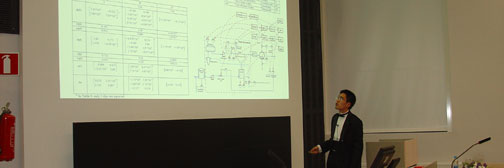| | Year 2001
Antti RemesEffects of the XRF analyzer accuracy and sampling frequency on the control performance of flotation
The object of this thesis was to study the control performance of the flotation process as a function of the measurement accuracy and sampling frequency of an XRF analyzer. An additional aim was to determine how the economical viability of the copper dressing process depends on the quality of process control.
Control of the flotation process requires concentration measurements from several process lines. The XRF analyzer can be used to analyze the concentrations of slurry lines in a continuous cycle. The control performance depends on the analytical accuracy and sampling frequency of the concentration measurement. With a long cycle time, the state of the process changes before a new measurement becomes available. The XRF technique is based on x-ray fluorescence intensity. With shorter measurement times the statistical deviation of the computed x-ray pulses increases. In addition, the measurement accuracy depends on the concentration of the component to be measured from the slurry. The total error of measurement accuracy and sampling frequency can be minimized by optimizing the combination of measurement time and cycle time for each of the measurement lines.
In the literature part, the components of measurement accuracy and sampling and mathematical methods are studied. The theories of flotation, XRF technique and optimization of the flotation process were also briefly reviewed.
The experimental part was carried out by constructing a dynamic process model in the Matlab environment. The modelled process was the copper flotation circuit of the Pyhäsalmi mine. The Pyhäsalmi process and the Courier analyzer were first described. The components of the accuracy of XRF analysis were also classified according to Gy’‘s theory. The model comprises a first order reaction equation and the grade-recovery -relationship estimated from the process data.
The total accuracy of the on-line XRF measurement with different measurement times and sampling frequencies was estimated by means of the process simulations. The optimal measurement times for concentrate, feed and tailings were determined as a function of sampling frequency. The optimal degree of filtering was also studied. The economical result of the process declines strongly when the sampling cycle is increased. The economical viability of the simulated Pyhäsalmi process corresponds to an almost uncontrolled process when sampling cycles longer than 40 min were applied.
Deprecated: strlen(): Passing null to parameter #1 ($string) of type string is deprecated in C:\WWWroot\Root\incs\5_theses\theses_new2010.php on line 248
This info last modified 27 Apr 2024 - contact webmaster
|

